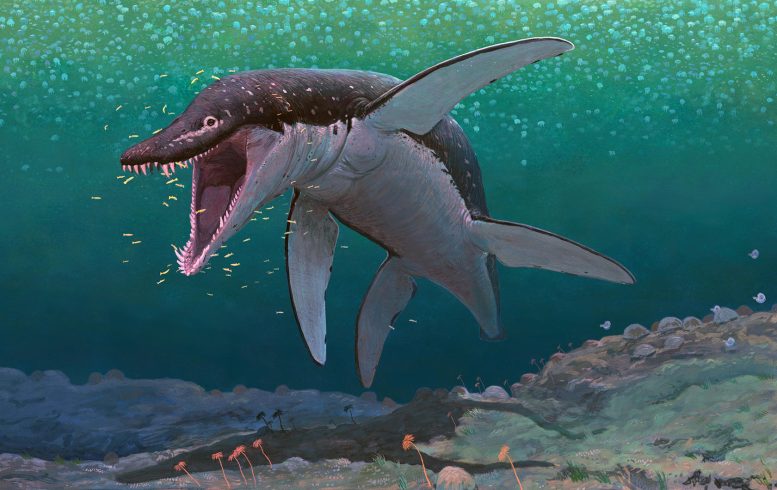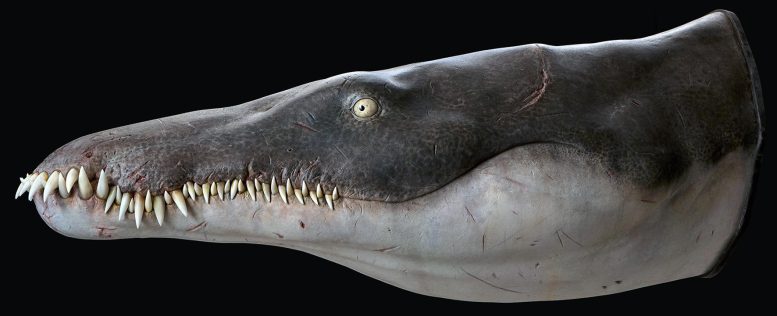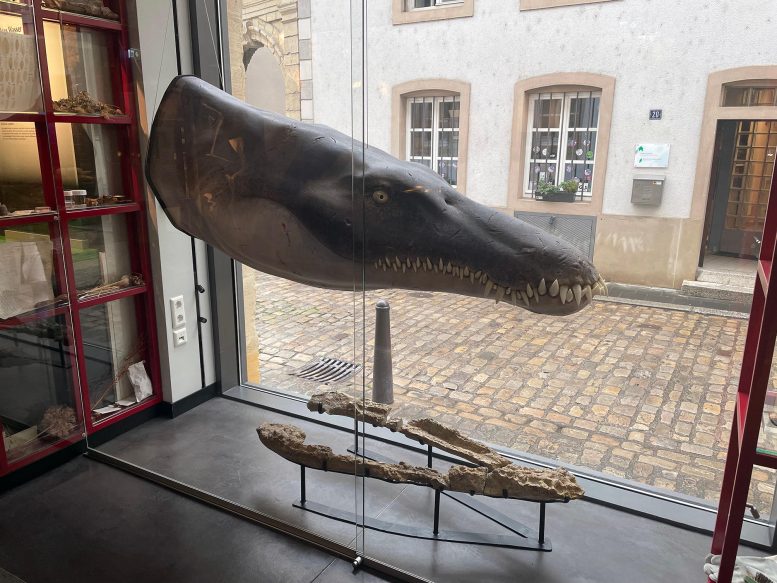
The oldest megapredatory pliosaur, Lorrainosaurus, in the ancient Middle Jurassic sea that covered what is to day northern France 170 million years ago. Credit: Joschua Knüppe
The fossils of a 170-million-year-old ancient marine reptile from the Age of Dinosaurs have been identified as the oldest-known mega-predatory pliosaur. This group of ocean-dwelling reptiles is closely related to the long-necked plesiosaurs. This significant find was reported in the journal Scientific Reports and offers new insights into the evolution of plesiosaurs.
The fossils were found 40 years ago in north-eastern France. An international team of paleontologists from the Naturkunde-Museum Bielefeld in Germany, the Institute of Paleobiology of the Polish Academy of Sciences in Warsaw, Poland, the Natural History Museum in Luxembourg, and The Museum of Evolution at Uppsala University in Sweden have now analyzed them and identified them as a new pliosaur genus: Lorrainosaurus.
Characteristics and Significance of Lorrainosaurus
Pliosaurs were a type of plesiosaur with short necks and massive skulls. They appeared over 200 million years ago but remained minor components of marine ecosystems until suddenly developing into enormous apex predators. The new study shows that this adaptive shift followed feeding niche differentiation and the global decline of other predatory marine reptiles over 170 million years ago.

Life-sized reconstruction of the head and jaws of the oldest megapredatory pliosaur, Lorrainosaurus. Credit: Model By 10 Tons
Lorrainosaurus is the oldest large-bodied pliosaur represented by an associated skeleton. It had jaws over 1.3 m long with large conical teeth and a bulky ‘torpedo-shaped’ body propelled by four flipper-like limbs.
“Lorrainosaurus was one of the first truly huge pliosaurs. It gave rise to a dynasty of marine reptile mega-predators that ruled the oceans for around 80 million years,” explains Sven Sachs, a researcher at the Naturkunde-Museum Bielefeld, who led the study.
Pliosaurs in Historical Context
This giant reptile probably reached over 6 m from snout to tail, and lived during the early Middle Jurassic period. Intriguingly, very little is known about plesiosaurs from that time.
“Our identification of Lorrainosaurus as one of the earliest mega-predatory pliosaurs demonstrates that these creatures emerged immediately after a landmark restructuring of marine predator ecosystems across the Early-to-Middle Jurassic boundary, some 175 to 171 million years ago. This event profoundly affected many marine reptile groups and brought mega-predatory pliosaurids to dominance over ‘fish-like’ ichthyosaurs, ancient marine crocodile relatives, and other large-bodied predatory plesiosaurs”, adds Daniel Madzia from the Institute of Paleobiology of the Polish Academy of Sciences, who co-led the study.

The 1.3 m long lower jaw of Lorrainosaurus with a life-sized reconstruction of its head displayed in the Musée national d’histoire naturelle de Luxembourg. Credit: Model By 10 Tons
Pliosaurs were some of the most successful marine predators of their time.
“Famous examples, such as Pliosaurus and Kronosaurus – some of the world’s largest pliosaurs – were absolutely enormous with body lengths exceeding 10 m. They were ecological equivalents of today’s Killer whales and would have eaten a range of prey including squid-like cephalopods, large fish, and other marine reptiles. These have all been found as preserved gut contents”, said senior co-author Benjamin Kear, Curator of Vertebrate Palaeontology and Researcher in Palaeontology at The Museum of Evolution, Uppsala University.
Origins and Later Findings
The recovered bones and teeth of Lorrainosaurus represent remnants of what was once a complete skeleton that decomposed and was dispersed across the ancient sea floor by currents and scavengers.
“The remains were unearthed in 1983 from a road cutting near Metz in Lorraine, north-eastern France. Paleontology enthusiasts from the Association minéralogique et paléontologique d’Hayange et des environs recognized the significance of their discovery and donated the fossils to the Natural History Museum in Luxembourg”, said co-author Ben Thuy, Curator at the Natural History Museum in Luxembourg.
Other than a brief report published in 1994, the fossils of Lorrainosaurus remained obscure until this new study re-evaluated the finds. Lorrainosaurus indicates that the reign of gigantic mega-predatory pliosaurs must have commenced earlier than previously thought, and was locally responsive to major ecological changes affecting marine environments covering what is now western Europe during the early Middle Jurassic.
“Lorrainosaurus is thus a critical addition to our knowledge of ancient marine reptiles from a time in the Age of Dinosaurs that has as yet been incompletely understood”, says Benjamin Kear.
Reference: “The rise of macropredatory pliosaurids near the Early-Middle Jurassic transition” by Sven Sachs, Daniel Madzia, Ben Thuy and Benjamin P. Kear, 16 October 2023, Scientific Reports.
DOI: 10.1038/s41598-023-43015-y








Be the first to comment on "Sea Monster Surprise: Ancient Pliosaur Remains Challenge What We Knew"